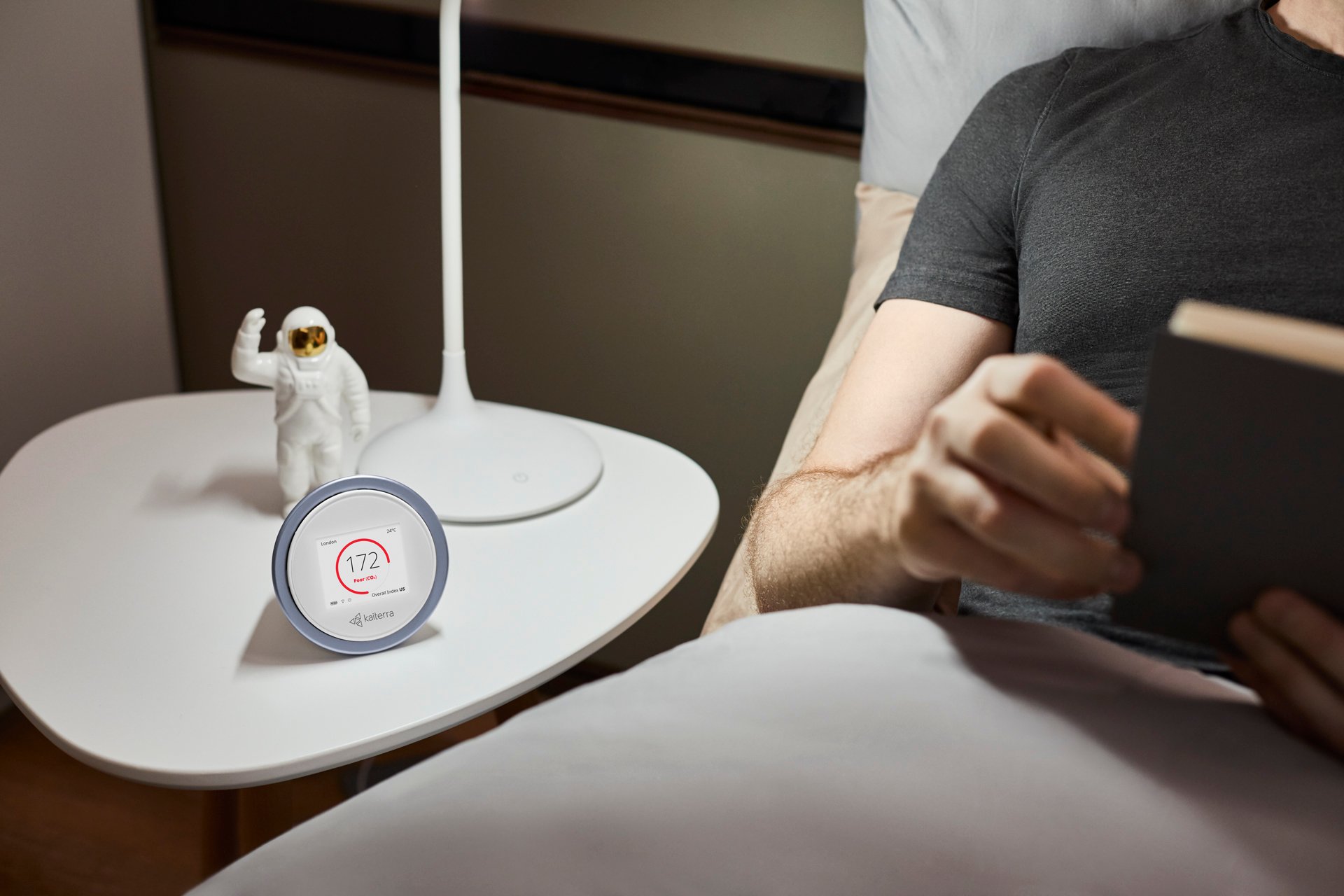Your Guide to Indoor Air Quality

Our homes are designed to protect us from the outdoors, but bad indoor air quality can sometimes get in our way of healthy living. Because modern homes are sealed tight against outdoor elements, indoor air pollutants and substances emitted within our homes can’t escape. As a result, the air inside our homes is often more polluted than outdoor air (even up to 100x’s).
As a growing concern worldwide, we are beginning to recognize the critical role indoor air quality plays in our health and wellness. Understanding indoor air quality and the interplay between indoor pollutants and our bodies is the first step in improving and optimizing your air.
With this in mind, we created a guide that provides an overview of indoor air quality. In this post, we will explore:
Your Guide to Indoor Air Quality
- What is indoor air quality?
- What are some common indoor air pollutants?
- How does indoor air pollution impact our health
- Strategies and technology to improve your indoor air quality
What Is Indoor Air Quality?
Indoor air quality is the air quality within and around buildings, including homes, offices, schools, shopping malls, and more.
Since we spend the majority of our time indoors, indoor air quality plays an enormous role in our health and overall well-being.
What Are Some Common Indoor Air Pollutants?
The first step in tackling your IAQ is to understand what’s in the air you breathe. By identifying what’s polluting your home, you can take action against indoor air pollution.
Indoor air quality has many contributing factors, including outdoor pollution levels and substances within your home. You can click the link on the right to read more about outdoor air pollutionRead more about this in our dedicated article., and keep reading for a breakdown of some common air pollutants that appear in our homes.

Substances within our homes can be a source of indoor air pollution.
Particulate Matter (PM)
Particulate matter is a form of air pollution created by other ambient pollutants, like ozone and nitrogen oxides, and directly through both outdoor and indoor combustion.
If you live in a smoggy city, keep an eye out for local AQI readings to protect your and your loved ones from particle pollution, as these tiny particles can sneak into our homes through windows, doors, and walls. Many governments and research organizations will publish air quality readings online, and you can access your local AQI readings by web or mobile apps, including the Kaiterra App.
Other than the outdoors, particulate matters can also be produced by common indoor activities, such as cooking, burning candles, using fireplaces, and cigarette smoking. However, particulate matters indoors often go undetected and can put on a negative impact on our health.
Volatile Organic Compounds (VOCs)
Volatile organic compounds are chemicals emitted directly into our homes through everyday household products. These carcinogenic substances, like formaldehyde, benzene, and ethanol, can be found in paints, cleaners, detergents, and polishes.
New building materials also emit chemicals, so if you live in a new or recently renovated home, that new home smell could be harming your air quality.
Carbon Monoxide (CO)
Carbon monoxide is a gas created by burning fuel. Carbon monoxide is both an outdoor and indoor pollutant, most often building up inside garages or areas where there is burning fuel. Carbon monoxide at excessive levels can result in serious health issues and even death. Luckily, many households today already have CO alarms built in so that we can take actions immediately when there is excess carbon monoxide in our air.
Carbon Dioxide (CO2)
Not to be confused with carbon monoxide, carbon dioxide is an atmospheric gas that is critical for life to exist on Earth. However, concentrations of carbon dioxide can rapidly increase inside buildings from human breathing, cooking, and burning candles. Buildups tend to happen in crowded, tight spaces with poor ventilation, so be sure to let in some fresh air regularly.
Radon
A radioactive gas, radon seeps indoors from the soil beneath our homes. Radon is more common in suburban or rural areas, but can even pollute city apartments. You should get you home tested at least once, especially if you’re moving into a new home. You can’t see or smell radon and should get your home tested for radon if you think levels may be high.
Mold
Molds are a type of fungi that grows in warm, damp spaces like basements or showers. When molds release spores into the air, they can negatively impact air quality, causing allergy and asthma flare ups. Molds are found in every home, but are more common in humid areas and cramped homes or apartments.
Dander and Dust Mites
Dander is organic material sloughed off of humans, pets, and other organisms. Dust mites are microscopic organisms that are common in many homes. Both of these can prompt allergic reactions in sensitive individuals and irritate asthma symptoms. Carpets, beds, blanket? People with asthma, or pets should look out for these items.
Indoor Air Quality Impacts on Your Health and Wellness
Maintaining a healthy indoor environment is vital for the wellness of you and your family. Bad air quality can not only harm the lungs, but also other parts of the body, including the brain, heart, and nervous system. People who spend a lot of time at home, like children, pregnant women, or elderly relatives, are especially susceptible to the health risks of bad indoor air quality because they are exposed to indoor air pollutants for longer.

Children are at higher risks of bad indoor air quality.
Among those common indoor air pollutants, we want to specifically discuss the health impact of PMs, VOCs, and CO2. For carbon monoxide, there is generally high awareness around the topic and many households today have built-in CO alarms. And when it comes to radon, there isn't much you can do on your own and you need to seek help from emergency services of a state agency.
For PMs, VOCs, and CO2, on the other hand, these pollutants are more "silent". The health impacts of these three pollutants are less frequently discussed, so we wanted to take a deep dive into these three so you have a full understanding of indoor air quality.
Particulate matter, in particular, can have lasting impacts on the brain and body. Breathing in particle pollution can hurt the lungs and heart of you and your family, and exacerbate existing respiratory conditions. Beyond just physical impacts, PM2.5 is small enough to enter your bloodstream and reach your brain, creating cognitive difficulties.
VOCs are carcinogenic substances, with an array of short-term and long-term physiological impacts. Symptoms of exposure can range from eye, nose, and throat irritation and sneezing to nausea and headaches. If you have allergies or asthma, pay particular attention to volatile organic compounds, as they can cause symptom flare ups.
Carbon dioxide itself is not poisonous, but it can harm humans at high concentrations. In small or crowded spaces, like offices, meeting rooms, and schools, carbon dioxide build ups are common. When build ups occur, you may have difficulty concentrating, develop a headache, and won’t feel your best.

CO2 at higher concentrations can affect our sleep, productivity, and overall wellbeing.
Strategies and Technology to Improve and Protect Your Indoor Air Quality
There are many tools and strategies you can implement to clean up your indoor air quality. From handy tech gadgets to building small daily habits, you can try to incorporate a few into your life and build a healthier home.
Invest In An Air Purifier
One of the most common solutions to indoor air quality issues, air purifiers help strain and remove air pollutants from your home. These devices are very beneficial in improving your air quality, as they directly remove pollutants instead of diluting them.
Get An Air Quality Monitor
When it comes to indoor air quality, utilizing an air quality monitor is essential in maintaining your indoor environment and maximizing your other gadgets.
Air quality monitors, like the Laser Egg, complement air purifiers. While air purifiers are very beneficial, they can’t differentiate between what has been removed and what pollutants may still be floating around. This is where an air quality monitor comes in. Used in conjunction with an air purifier, air quality monitors detect pollutants in your air, letting you know when you need to turn on your air purifier or open the windows.

An air quality monitor can help you understand your indoor air quality.
Ventilation is Key
Ventilation is one of the easiest and most effective ways of dealing with indoor air pollutants. When outdoor pollution levels are safer, opening your windows and turning on a fan can release trapped chemicals and gases into the outdoors. The toxins will dilute with the ambient air and give your indoor air quality a hearty boost.
Opt for Cleaner Products
Many household products contain dangerous, carcinogenic chemicals. Luckily, there are substitutes available for your use to limit the toxic substances released into your air. When possible, opt for natural household products and cleaners, and always check the ingredient list.
Say No to Smoke
Smoking cigarettes releases dangerous chemicals, like formaldehyde and benzene, into the air and your lungs. The best policy is to avoid smoking inside your home to protect you and your loved ones. If you must smoke indoors, be sure to open a window and vent out foul toxins.
Other sources of smoke in your home can also diminish your air quality and produce carbon dioxide. Make sure you open a window to release this gas and smoke when burning candles, lighting incense, cooking, or using the fireplace.
Build Daily Healthy Rituals
Some simple changes in your schedule can go a long way in improving indoor air quality. Vacuuming and dusting more often, keeping your counter tops and bathroom clean and dry, and doing laundry before the clothes pile up are all easy, achievable things you can do to reduce air pollutants inside your home.


Laissez un commentaire